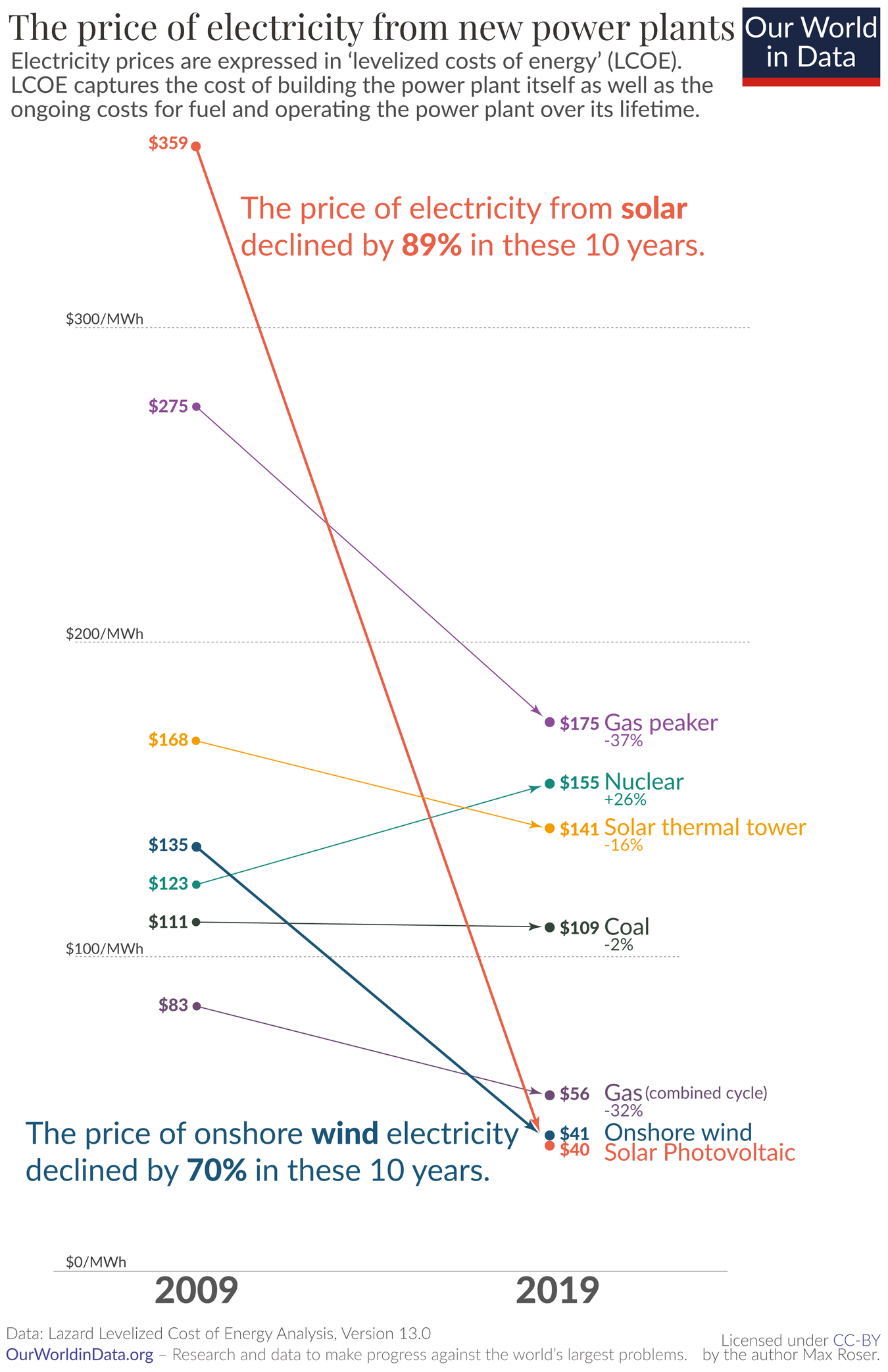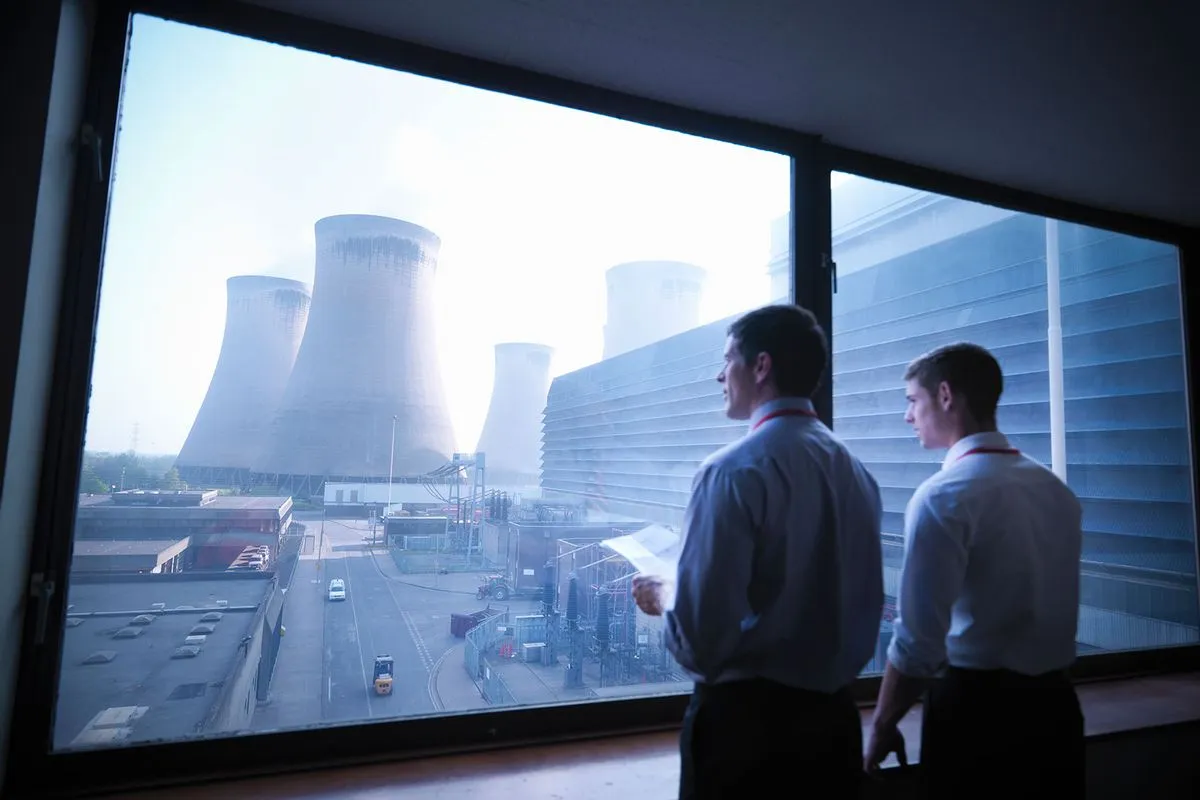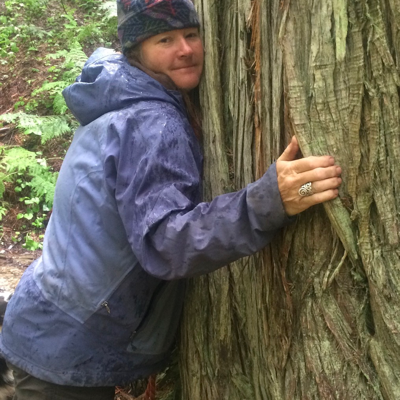Nuclear power is still better than burning fossil fuels regardless, and probably has a role to play as a scaleable demand-responsive source.
However for the past decade or so, every time a new nuclear project starts the cost of wind and solar drops substantially before it’s complete. This absolutely ruins the nuclear project’s original cost/benefit analysis and makes continued spending on it look irresponsible. Wind and solar are outcompeting everything else, which is probably a good thing overall. If energy storage tech becomes more affordable/effective we might not need nuclear at all.
The appeal of solar and wind for me is how they can enable a decentralized grid. Anyone could set up these utilities according to their needs, which builds societal independence. Also means less resources are likely to be needed overall.
If by decentralized you’re mainly referring to rooftop solar, it’s unfortunately the least cost-effective way to generate electricity. The $/MWh for rooftop solar is even higher than nuclear on average. Wind and solar are more cost-effective in grid-scale installations. A decentralized/individualized grid would actually require more resources.
Right but if you’re off grid, it’s kind of irrelevant what in-grid costs, it’s just nice that it’s an option at all and that it keeps getting cheaper.
Yeah, grid-scale is exactly what I had in mind. I admit, I’m not knowledgeable in utility engineering. Looks like some research is in order. :)
Roof top solar is also a terrible idea due to the huge safety issue it raises for utility workers trying to maintain or repair damaged lines. How do you quickly and safely isolate dozens if not hundreds of houses feeding into the same line if they are all feeding power into the grid? It sounds like a corp shill line but if you’re going rooftop solar you should go fully off grid due to the potential danger your panels can cause in any down line situation.
deleted by creator
Salon has no respect from me, so I’m not going to generate a click for them.
Since I’m not too familiar with nuclear - how would the on-demand scalability work? My impression has always been that reactors are generating energy at a fairly constant rate.
Oh no, the whole point of control rods is to adjust the rate of reaction in the core, which adjusts the rate of neutron output which adjusts the rate of steam production. Newer reactor designs are even more flexible in how the rods can be used.
deleted by creator
Not really. Reaction change when moving the rods is almost instantaneous. Random spikes in grid usage are not that random and any competent power providers can predict and plan accordingly. The only real concern is decay heat things like xenon build up down the road, again something the industry can predict and plan around as standard practice and western built reactors have safety systems built around preventing those factors from becoming serious issues.
Huh, the more you know. I always though the rods were only adjusting it at a single percentage point rate, just enough to not let it blow up!
Thanks for the answer!
has a role to play as a scaleable demand-responsive source
Nuclear is best used a base load, it scales in the sense that you can build more plants, but the plant output can’t be adjusted as rapidly as the tiny natural gas turbine plants, reservoir-storage, battery array, or other sources.
The best use for nuclear output in a surplus phase would be storing the energy (water reservoir pumping, battery arrays, etc.) or expensive wasteful processes (electric steel plant ovens, hydrolysis to generate hydrogen fuel.)
“Experts” don’t think it’s too dangerous. Paid OPEC shills like this journalist pretend it’s too dangerous.
Ontario, Canada is a fantastic display of safe nuclear, we CANDU anything!
Every expert who has the slightest idea what they are talking about says we need more nuclear, solar and wind and to take oil, gas and hydro offline and out of the grid due to ecological concerns.
The experts are right; there are real and serious risks with nuclear energy. However, there’s one huge benefit: you can increase power generation on-demand. If it’s calm and overcast, you make not be able to generate significant power from wind or solar, and nuclear can fill that gap. On days where you can generate a lot of power from solar or wind, you can decrease the amount of power that a nuke plant is generating.
I think that we’re going to need more nuclear, even as we build more and more renewables.
Personally, I’m expecting solar and wind energy to become so cheap to produce, i.e. multiple times cheaper than nuclear, that storage can be paid from that difference.
Here’s a fun graph illustrating the current trends:

I hope that’s true, but so far, there aren’t great solutions for large-scale electricity storage. For individual users, you can get large lithium-ion batteries that can store enough power for 2-3 days for a typical American home, but last time I checked those were in the $5000+ range, exclusive of the costs of wiring your home so that you have an immediate back-up in case of power failure.
And, just so I’m clear, I’m 100% in favor of renewables like hydro, solar, wind, and even waves.
The only reason nuclear is not outpacing solar and wind right now is because nuclear phobia about accidents that happened before half their critics were even born and those flaws fixed a long time ago. If Nuclear benefitted from the same RnD and public support as other green energy sources we probably would have functional thorium reactors so cheap to run rural comminities could run co-ops operating minature versions to power towns under 1000 homes.
Despite nuclear being shunned and forced out using technology thats stagnated since the 80s its still competitive. With renewed funding and grants to develop further generations of reactors they could easily be the cheapest and safest per kwh bar none.
Competing for land space will surely not be a problem…
I hate the argument that nuclear is unsafe. Sure its unsafe, but how is killing the ocean with record temperatures caused by coal and other fossil fuels any safer?
Greenhouse gases are polluting the air we breathe. Seems pretty unsafe to me to be emitting literal metric tons into the atmosphere for all of us to choke on.
Because fuck logic.
While that’s true, the counter arguments are Fukushima, Three Mile Island, and Chernobyl.
The risk with nuclear is that we trade one problem–climate change caused by CO2 emissions–for another significant problem down the road.
At the same time, climate change is here now, and we need to act or else there isn’t going to be anything we need to worry about in a century.
deleted by creator
What are you talking about? Yes, you absolutely can. The control rods speed up or slow down the reaction, which in turn changes how much heat it’s pumping out, which controls how much electricity is being generated. Nuclear output isn’t a single constant, always giving exactly the same number of megawatts of power.
But the amount of cycles is not limitless, thermal and pressurefluctuations lead to material weakness over time. And a steeper gradient leads to faster deterioration
deleted by creator
A response time of several minutes for grid balancing is on par with large scale hydropower, and often quicker than combined cycle plants. The whole reason why we put all our major power plants together into an electrical grid is to cause any change in demand or supply to take a lot of time to have an impact.
Nuclear can generate in the evening during peak demand and at night without needing enough batteries to last supply the entire grid for 12 to 18 hours and unlike wind isn’t heavily location dependent.
deleted by creator
Flywheel storage is not a serious solution for anything but adding inertia to the grid, where it is sometimes brought up as an expensive solution to the fact that unlike hydro, geothermal, coal, oil, combined cycle, and yes nuclear, solar and wind have no intera because unlike all the previously mentioned modes of generation they have no flywheel built in.
If energy stoage is a problem for nuclear, than it is literally at least a hundred times larger one for solar. You might need to store a tiny inbalance for nuclear, you need to store the entire grid capacity for the entire night with solar. It also ignores that you can run an entire power grid on nuclear and hydro, we know because entire nations have been actually doing it since the seventies.
Wind absolutely cannot be built anywhere at grid scale. There are relatively few areas where it is consistent enough to generate a worthwhile output. Solar will output with indirect lighting or when cloudy, but only at a third to a quarter of its direct sunlight output, and it does require both massive tracks of land and along with wind has massive trouble with nimbys blocking new development and the necessary scale up in tranmision lines.
This is not to say that solar and wind are unworkable obviously, just that they are nither easy nor without major downsides. This is why a well designed grid has a diverse set of sources and doesn’t just rely on uncontrollable sources like solar and wind. Nuclear does a very good job of providing consistent green energy on calm nights and can be built just about anywhere without requiring the large open land of solar or the strong constant breeze of wind.
Waste really isn’t a serious concern. The vast majority is low level stuff like used clean suits and gloves that are only a problem for decades, and you can glassify or recycle the high level stuff. We just often don’t bother because compared to the massive open pits of toxic chemical waste that will be just as deadly in a trillion years as it is today, and which are created by producing everything from your phone and laptop to solar panels, there just really isn’t enough of it to cause the problems thouse other types of toxic waste do.
deleted by creator
The flywheel design you linked was exactly what I was talking about. A system designed purely to add inertia to the grid, not ment for energy storage.
France was the nation alluded to that has run largely on nuclear for nearly half a century now.
I know what the newest generation of wind trubines are capable of, indeed I am going to local government meetings to try and keep Nimbys from blocking such a large scale development in my area. Thouse very consistent winds newer turbines are reliant on are only present in certain areas, which is why large projects have to be sited in thouse specific areas. You can’t just put a row of turbines wherever demand is and expect it to work.
Most toxic chemical waste by volume are things like heavy metals and such that will never, ever, break down. They are far more deadly to humans and animals than high level radioactive waste, which after a few centuries is more dangerous because of its toxicity than because of its radioactivity. Because of the danger and difficulty in safely storing such waste forever, production has also been largely outsourced to nations in Southeast Asia and Africa where environmental enforcement is corrupt and ineffectual if foreign lobbying can’t keep it from being written at all.
The waste produced is often stored in open unlined ponds which may at best and if the company went above and beyond have a clay or plastic liner to limit ingress into the local water table. This method has actually killed people, indeed it kills a lot of people every year, and will continue to pose a health hazard to the drinking water even if these nations take on the often billions of dollars per site in restoration and cleanup, which mostly involves moving this waste to a better designed enclosed pit like are used in richer nations because again, this waste will never be safe and can kill people in a million years just as easily as it does today.
Radioactive waste is well known among the public, but its far from the most dangerous kind of waste we make.
Opportunities are higher for wind and solar than for nuclear IPCC AR6 page 28 https://report.ipcc.ch/ar6syr/pdf/IPCC_AR6_SYR_SPM.pdf
deleted by creator
Vapor really isn’t a problem, most of the water in nuclear return back to the source as water, and the vapor rains back.
Renewables are definitely the way to go, but nuclear is needed as base source when renewables are not bringing in the needed electricity/heat.
deleted by creator
Modern nuclear plants do not have these large vapor coolant towers, because it recycles the vapor and water within the plant.
They use salty not drinkable sea water to cool the vapor back to water, without any contact from the vapor to sea water.
Busting nuclear because vapor or water is just fear mongering without any basis on reality. There are other negative things with nuclear that so base in reality, like the fuel output and fuel dependency on uranium.
deleted by creator
Tell me you know nothing about nuclear power generation without saying you know nothing about nuclear power generation.
Something that pollutes both ground and water is not a fix for climate change lmao
A nuclear power plant doesn’t pollute either of those more than any other large building, and sure uranium mining is still mining, but renewables and battery storage also depend on raw mined materials.
I hate the argument that nuclear is unsafe. Sure its unsafe, but how is killing the ocean with record temperatures caused by coal and other fossil fuels any safer?
Greenhouse gases are polluting the air we breathe. Seems pretty unsafe to me to be emitting literal metric tons into the atmosphere for all of us to choke on.
Because fuck logic.
Not as bad as something that spreads false info and fake news. Nuclear reactors don’t pollute their surroundings like that, all waste is containef on site. A camp fire pollutes the environment more than nuclear power plants are allowed to leak.






